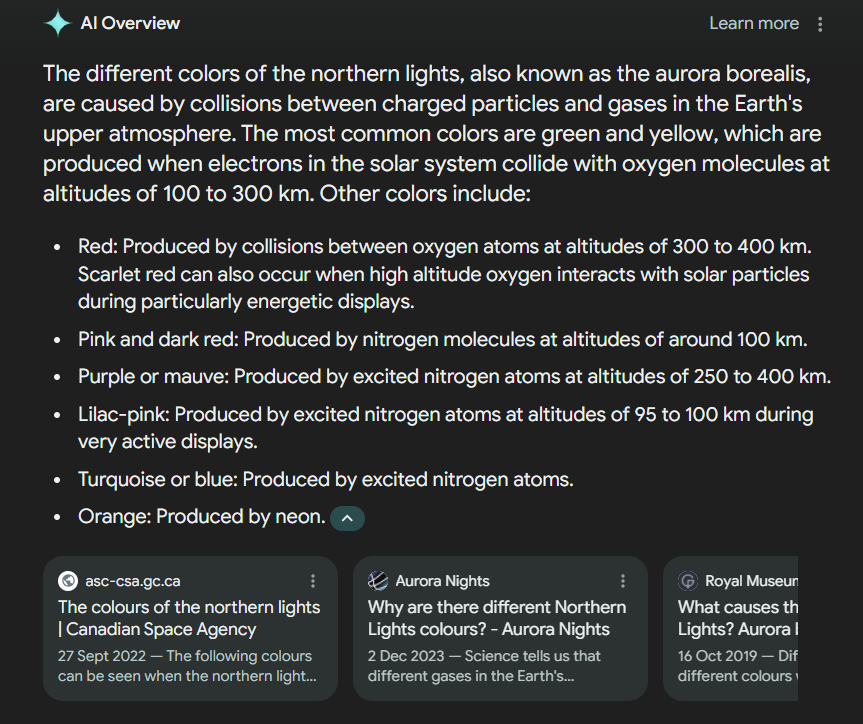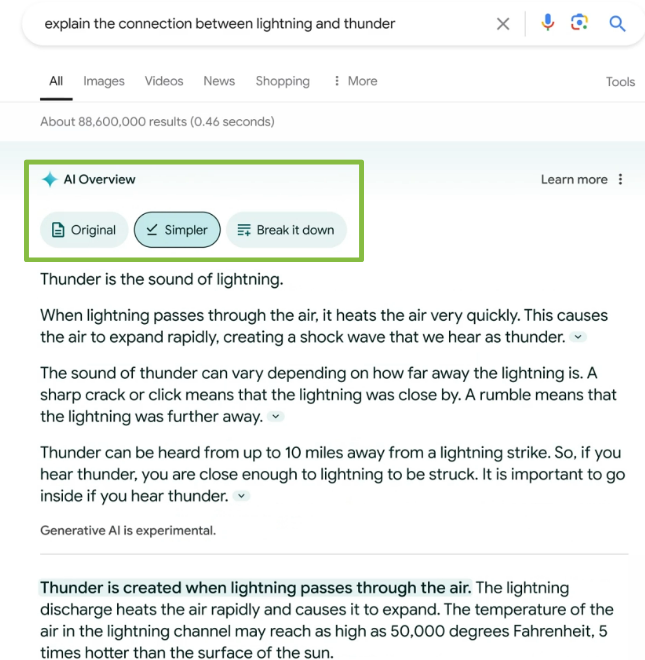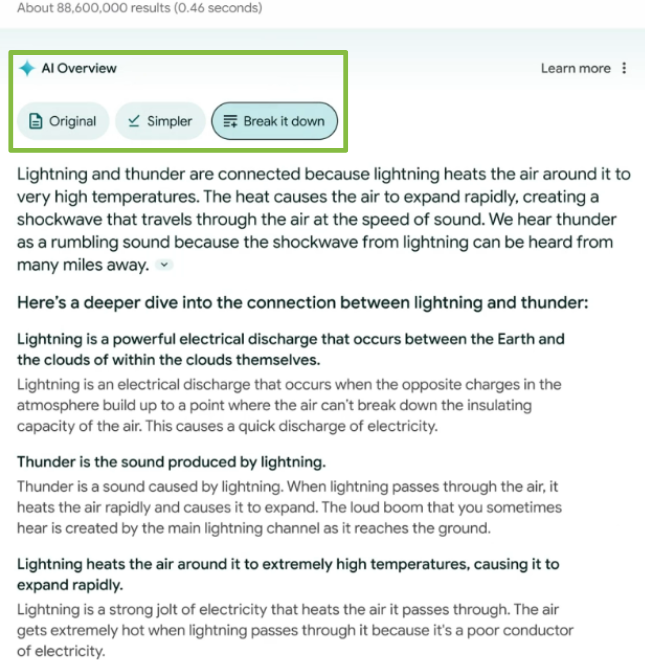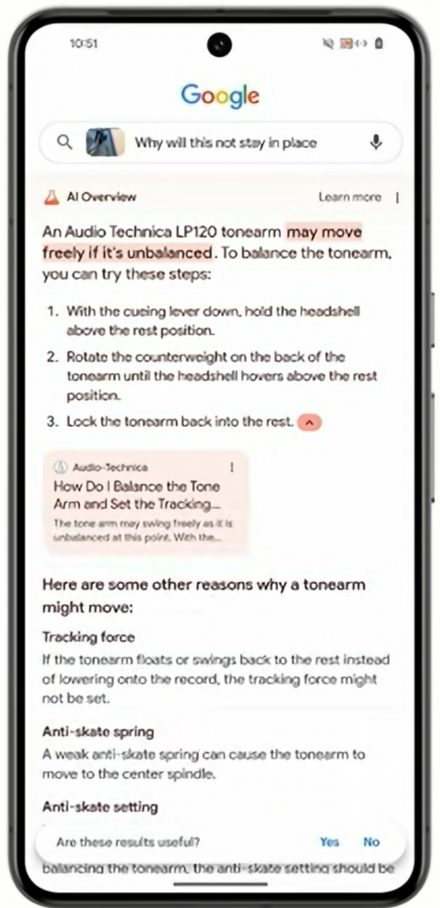During their 2024 I/O conference held on May 14th, Google announced that they had begun rolling out a rebranded SGE (Search Generative Experience) throughout the US — and that more countries would follow soon.
Now known as AI Overviews, Google’s generative search assistant will see an incremental launch around the globe, with rollout projected to continue over the next few months.
In this article, we discuss the key features of AI Overviews and what they mean for you and your digital marketing strategies.
What is an AI overview on Google?
AI Overviews is the new, more literal name for what you’ve most likely come to know as Google’s Search Generative Experience. For those unaware, it’s a generative AI search assistant that incorporates the best and most relevant information from a variety of sources in Google’s index into a response served directly to the user at the top of the SERPs.
Links to sources (called link cards) are included for continued research or fact-checking — as illustrated in the below screenshot of an AI Overview for the following query: ‘which elements produce which colours in the northern lights’

AI overviews are designed to produce more accurate and personalised query responses, helping to speed up the search process and improve the overall search experience.
When will AI Overviews be released in the UK?
Google’s AI Overviews have been in beta in the UK since early April, showing on results pages for select signed-in users, and we expect full implementation to happen over the next few months, if not the next few weeks.
As discussed in several of our previous posts leading up to Google’s 2024 I/O conference, AI Overviews will contribute towards a shift in search behaviour that will, in turn, change the way we approach SEO.
How common will AI Overviews be?
The chances of an AI overview appearing for a search varies depending on the search intent, search topic, and the way the search is structured.
Google has also been experimenting with different overview appearance frequencies, so just how common they’ll be is yet to be determined. But recent before vs after rollout tests suggest appearance frequency was dialled back significantly before the US launch.
In February, it was reported that SGE responses would feature in 84% of searches, dropping to 35% in May — and this includes queries that produce an option to generate, as opposed to those that trigger, an automatic overview.
This reduction in overviews is tied to the fact that early user beahvoiur observations have shown reduced enagement with ads when an overview is served. As such, queries that trigger ads will now not also trigger an AI overview, at least in the US.
We may experience a similar outcome in the UK, but Google could continue to adjust overview frequency based on post-launch engagement data. The current company line from Google is that an AI overview will only appear if it can add value to the user search experience.
It’s a vague statement, so it’s best to assume there might be some changes in this department as the dust settles post-rollout.
How much space will AI Overviews occupy?
Observations made by Brightedge throughout April 2024 found that, on average, then-named SGE AI snapshots were steadily shrinking, falling from 1,200 pixels at the start of the month to 1,050 pixels. To put this into perspective, those lost 150 pixels equate to roughly an inch of screen space.
It’s not entirely clear why the AI response is getting smaller, but it means that overviews won’t be quite as dominant as they were on the SERPs, giving traditional results a marginally better chance of getting noticed.
How will AI Overviews impact your organic traffic?
AI Overviews will lead to reduced clicks via traditional search results. How severe the dip in organic traffic will be remains to be seen, but it’s not all doom and gloom…
During a recent interview with Search Engine Land, Hema Budaraju, Senior Director of Google’s AI Overviews, claimed that clicks via overview link cards far exceed those received via traditional or even rich snippet search results.
Sadly, though, there’ll be no conclusive way to determine the fraction of clicks attributable to link cards, as Google will not differentiate them in Google Search Console. We think this could be remedied at some point in the future, but it might be low on Google’s priority list at the moment.
How is AI Overviews performing in the States?
While the majority of AI overviews served in the US have included relevant and detailed information, there have already been some notable hallucinations. The errors drawing the most press involve glue pizza and eating rocks.
Google was quick to respond, stating:
‘The examples [of errors] we’ve seen are generally very uncommon queries and aren’t representative of most people’s experiences. The vast majority of AI overviews provide high quality information, with links to dig deeper on the web.’
Google doesn’t have the best history in regard to AI launches — both Bard and its Gemini successor got off to rather shaky starts. But AI Overviews, despite some teething issues, doesn’t appear to be quite the flop. Google will be fine-tuning their new release based on the reported hallucinations, meaning it should be performing at a higher level by the time it sees a full UK release.
What you need to do
A full UK release of AI Overviews is imminent. If you haven’t already, you must start preparing for its arrival. Poised to reconfigure SEO priorities, it’s important to adjust your strategies to suit the challenges and benefits of AI search - and we can help.
At TDMP, we saw generative search coming a long time ago, and we’ve been meticulously fine-tuning our services ever since, ensuring our clients’ success in the new age of search. Get ahead of the competition by contacting TDMP today and start optimising for visibility in AI Overviews.
You can learn more about how AI search will impact digital marketing in our article discussing the aftermath of Google’s March core update.
AI Overviews — key features & must-knows
Google has been drip-feeding the public information about the AI formerly known as SGE for over a year, but nothing was set in stone with the technology still in its testing phase. However, the 2024 I/O event gave us our first conclusive glimpse of Google’s AI search tool — and here’s what you need to know.
From snapshot to full page
Early examples of SGE in action suggested that, while substantial, AI responses would be limited in terms of the space they occupied on the SERPs. These “AI snapshots” arrived at the top of the page, with the user having to scroll to access the traditional search listing below.
For the most part, this will remain the same, but, depending on the query, a user may now be presented with an entire AI page tailored to the intent of their search, removing traditional results from the equation.
Google illustrated this function with the following query:
‘anniversary celebration dinner places Dallas’
… which generated the following overview:
- Sponsored placements
- Anniversary-worthy venues - Suggested venues marked on a map segment and displayed as feature tiles beneath
- Celebratory Dallas restaurants - sourced from Reddit, with the option to view recommendations from additional forums
- Live music and intimate settings
- PAA (People Also Ask)
- Romantic steakhouses
- Critic picks for special occasions
- Venues with historic charm and elegance
- Popular dishes for anniversaries
- Unique anniversary dishes
- Rooftop patios for dates - Google knew that it was warm in Dallas when the query was entered, so it incorporated this information into the output, assuming that the searcher may be interested in al fresco dining.
While this means that the AI has wiggle room to present significantly more website links for further research, it perfectly encapsulates the concern that, outside of these AI-curated responses, clicks will go into decline.
The inclusion of PAA shows that rich snippets will still hold significant value. But, due to the tailored nature of the AI overview and the wealth of relevant information served, it seems likely that CTRs won’t be quite as impressive as they are for snippets on traditional SERPs.
Consequently, optimising for generative search will be a priority when AI Overviews become a normal part of the user journey across the UK and beyond.
Multi-step reasoning
Google also revealed the full extent of AI Overviews’ ability to parse and effectively respond to complex, long-tail searches, using a process called multi-step reasoning.
Multi-step reasoning is a means of satisfying multi-query searches efficiently. The example search Google provided during their I/O ’24 keynote was:
‘find the best yoga or Pilates studios in Boston and show details on their intro offers and walking time from beacon hill’
AI Overviews’ Gemini model breaks down the search into individual queries and uses reasoning to determine the order in which they should be answered. It then presents them in an organised manner. In this case, it offered four Boston yoga studios rated over 4.1 stars, their distance from the user, their intro offers, and a map segment showing a visual representation of and easy-access directions to the listed studios.
This functionality encourages longer search terms in both text and voice search — and highlights why optimising for local search is going to take centre stage for many businesses following the full release of AI Overviews.
User-contributed content is fair game
Google initially stated that SGE would not scrape user-contributed content. However, user tests and I/O ’24 demos show that Google’s AI Overviews often incorporate information from sites such as Reddit, resulting in further competition for businesses aiming to gain visibility in overviews.
With forums becoming a more integral part of mainstream search, we expect reputation management to play a larger role in SEO over time, helping to improve your brand’s overall online image and gain visibility in AI Overviews.
High-risk topics
It’s not just user-contributed content Google has done a U-turn on; they’ve also had a change of heart regarding queries related to medical, health and financial topics, which may now prompt an overview.
This might introduce an element of unease for some users, but in terms of digital marketing, it means that the opportunities presented by AI Overviews are accessible to a broader spectrum of industries.
Variable response styles
A feature (yet to be launched in the UK) allows users to choose between ‘Original’, ‘Simpler’ and ‘Break it down’ overview styles.
‘Simpler’ overviews omit or simplify technical details and relay the key information in a short, easy-to-follow passage, helping to make complex topics more accessible. We see this becoming a popular jumping-off point for tricky research projects or for easing children into dense subject areas.

Source: Google
‘Break it down’ overviews cover all the details, but present it in logically ordered, digestible chunks. Again, we see this being instrumental for research and education.

Source: Google
Video search
Google have been quietly tinkering away at multimodal AI for some time, attempting to train their systems to understand and respond to a variety of input formats, including video.
Released in 2017, Google Lens was the first fruit of their labour, enabling users to instigate searches with only an image. Now, this app can process video as well, and next on Google’s agenda is to link Google Lens to AI Overviews in order to serve AI responses to video searches.
For example, during Google’s live demo at their I/O 2024 event, footage of a record player with a misbehaving tone arm was captured using Google Lens. During the recording, presenter Rose Yao asked Google, ’Why will this not stay in place?,’ and Google responded with the AI Overview shown in the picture below.

Source: Google's YouTube
As you can see, the overview…
- Identifies the problem component as a tonearm
- Identifies the record player brand and model
- Suggests that the issue may be that the tonearm is unbalanced
- Provides a step-by-step guide for resolving the issue
- Offers a link to a how-to guide for more information
- Gives additional reasons why the tonearm may be malfunctioning
…which is pretty impressive, although whether video search & AI Overviews will work as smoothly in the wild is yet to be seen.
It’s unlikely that video search will become a prevalent user behaviour when compared to text and voice search, but as the video is a supplementary aspect of what is at its core a voice search, optimising for exposure should follow, broadly, the same principles.
Final thoughts
The release of Google’s AI overviews marks a turning point in search, and, by necessity, SEO. Acclimating swiftly to new circumstances will be key to weathering the initial turbulence and establishing a strong position in digital for your business.
Contact TDMP today for tailored digital marketing support and to take advantage of the opportunities presented by Google’s AI Overviews.

